Summary of Conference Room Designs
Designing a modern conference room is crucial for enhancing productivity, collaboration, and overall workplace satisfaction. Incorporating ergonomic furniture, advanced technology, and thoughtful layouts can create a comfortable and efficient environment. Distinguishing a conference room from a meeting room involves recognizing the different purposes and sizes, with conference rooms being larger and more formal. Smart conference rooms integrate technology to facilitate seamless meetings and improve communication. The primary purpose of a conference room is to provide a dedicated space for formal meetings, strategic discussions, and presentations, contributing to a professional and productive work setting.
Best 10 Conference Room Designs for Office
Conference rooms are pivotal spaces in any office, serving as the hub for meetings, brainstorming sessions, presentations, and crucial decision-making. Designing an effective conference room can significantly impact productivity, collaboration, and overall office aesthetics. Here are the top 10 conference room designs to inspire your work office transformation:
Why Design is Important in a Modern Conference Room?
Design plays a crucial role in a modern conference room, impacting both the functionality and the atmosphere of the space. A well-designed conference room can enhance productivity, foster collaboration, and create a positive impression on clients and visitors. By incorporating ergonomic furniture, advanced technology, and thoughtful layout, the space can be optimized for comfort and efficiency. Additionally, aesthetic elements such as color schemes, lighting, and décor contribute to a welcoming and inspiring environment. Effective design can also accommodate various meeting formats, from formal presentations to creative brainstorming sessions, ensuring the room is versatile and adaptable to the needs of the team. Ultimately, a thoughtfully designed conference room supports better communication, creativity, and overall workplace satisfaction.
What to Consider When Designing a Conference Room?
Here are some key things to consider when designing a conference room:
Functionality:
- User Needs: Who will be using the room? How many people typically attend meetings? What kind of meetings will be held there (brainstorming sessions, presentations, client meetings)?
- Technology: Equip the room with the right tech for video conferencing, presentations, and easy connection to devices. Consider whiteboards or interactive displays for collaboration.
- Furniture: Choose ergonomic furniture that’s comfortable for long meetings. Consider flexible furniture arrangements to suit different meeting styles.
- Acoustics: Control noise with sound-absorbing materials on walls and ceilings.
Ambiance:
- Lighting: Use natural light if possible. Supplement with adjustable lighting to create the right mood.
- Temperature Control: Ensure the room is comfortable year-round with proper heating and cooling.
- Colors and Decor: Create a professional yet inviting atmosphere. Consider your company branding and use colors that promote focus and engagement.
- Minimize Distractions: Keep the space organized and free of clutter.
Additional Considerations:
- Accessibility: Ensure the room is accessible to people with disabilities.
- Location: Place the conference room in a quiet area to minimize disruptions.
1. The Classic Boardroom
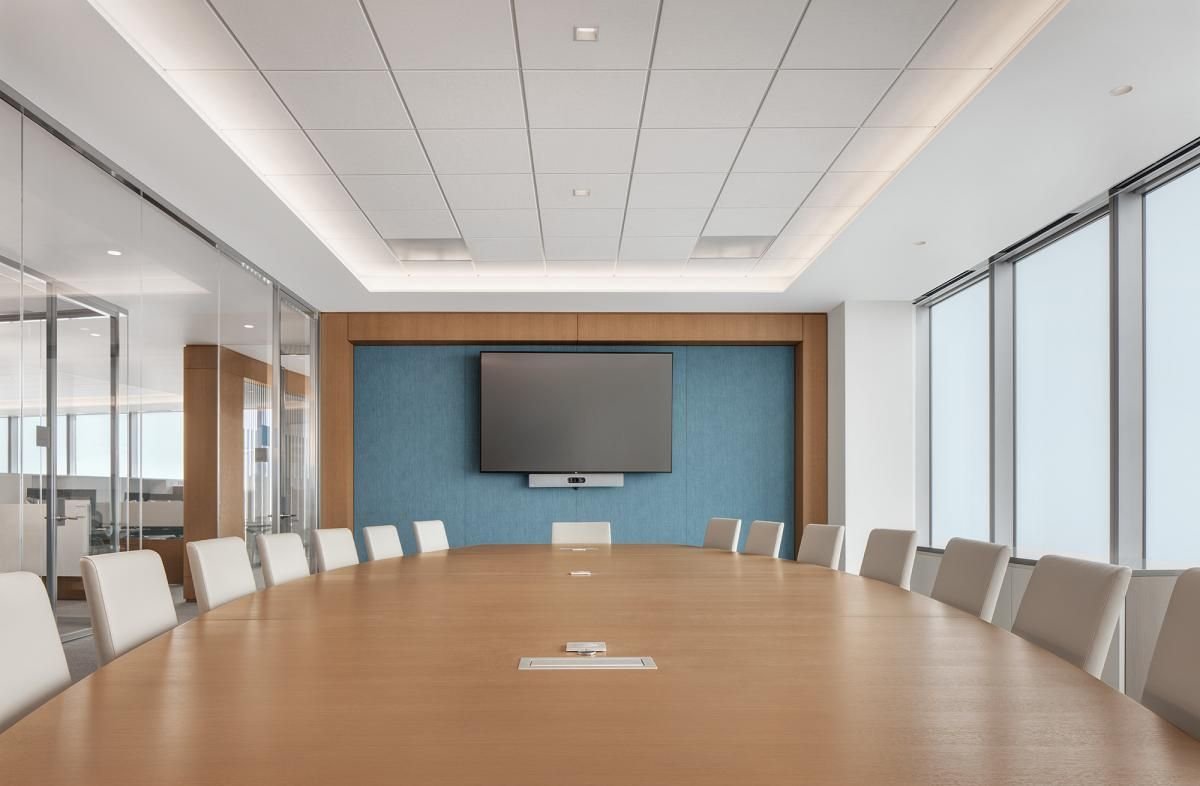
Design Features:
- Long, rectangular table with ample seating.
- High-back executive chairs for comfort.
- A large screen or projector for presentations.
- Minimalistic décor with neutral colors and professional artwork.
Why It Works:
The classic boardroom design exudes professionalism and is ideal for formal meetings, client presentations, and executive discussions. The long table ensures everyone has a clear view of each other, promoting better communication.
2. The Collaborative Hub
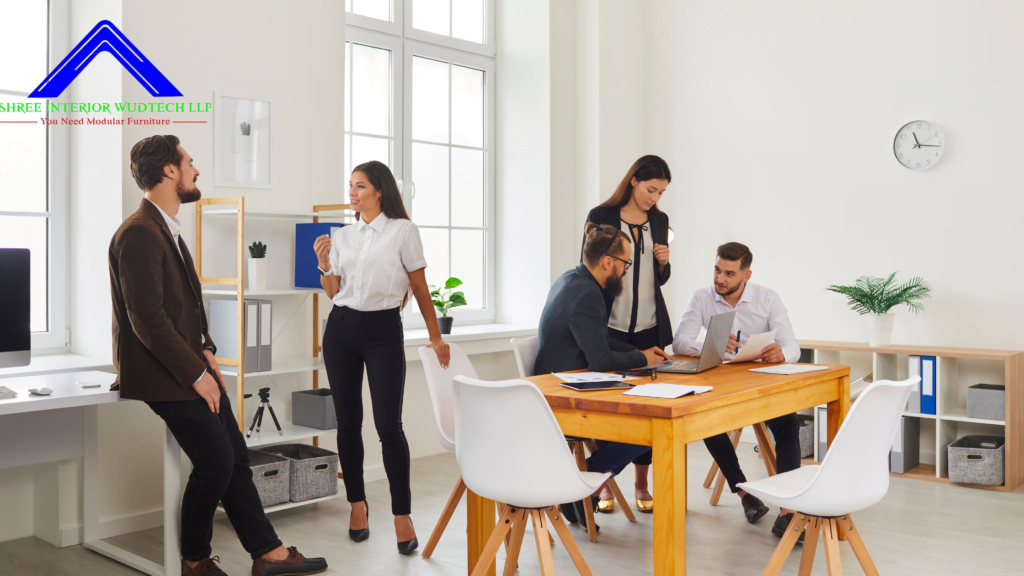
Design Features:
- Round or oval table to facilitate inclusivity.
- Whiteboards and sticky notes for brainstorming.
- Comfortable, movable seating for flexibility.
- Bright colors and creative décor to spark inspiration.
Why It Works:
This design encourages collaboration and creative thinking. The round table ensures no one feels left out, and the flexible seating allows for dynamic rearrangements based on meeting needs.
3. The Technology-Integrated Room
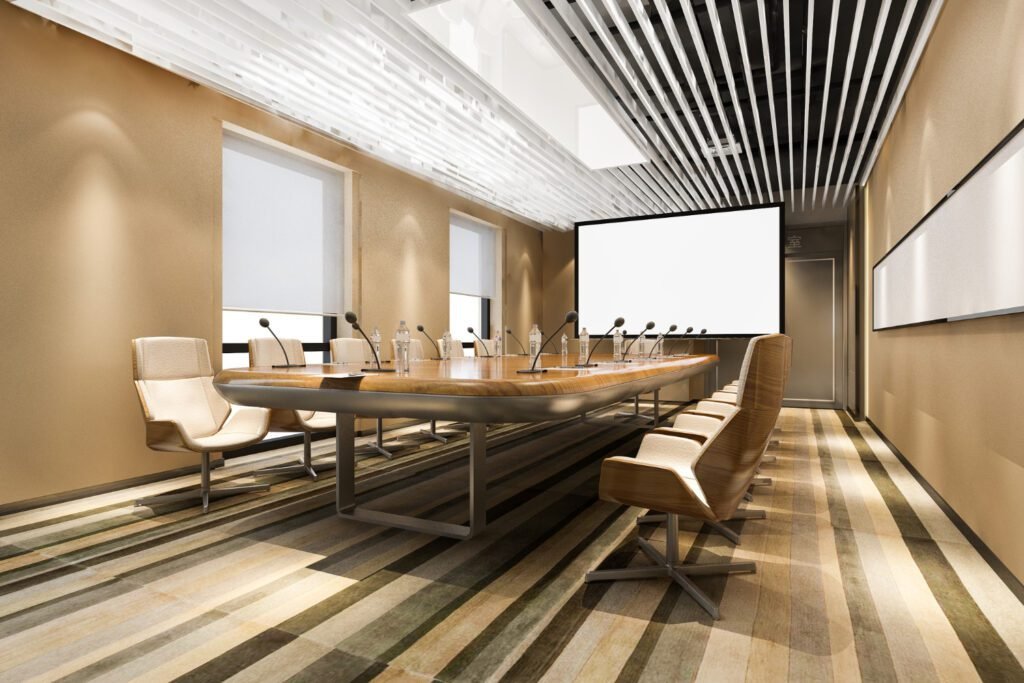
Design Features:
- State-of-the-art AV equipment.
- Interactive smart boards.
- High-speed internet and multiple charging stations.
- Soundproofing for clear audio and privacy.
Why It Works:
Ideal for tech-driven companies, this design integrates the latest technology to support virtual meetings, presentations, and collaborative work. The smart boards and soundproofing enhance the overall meeting experience.
4. The Lounge-Style Space
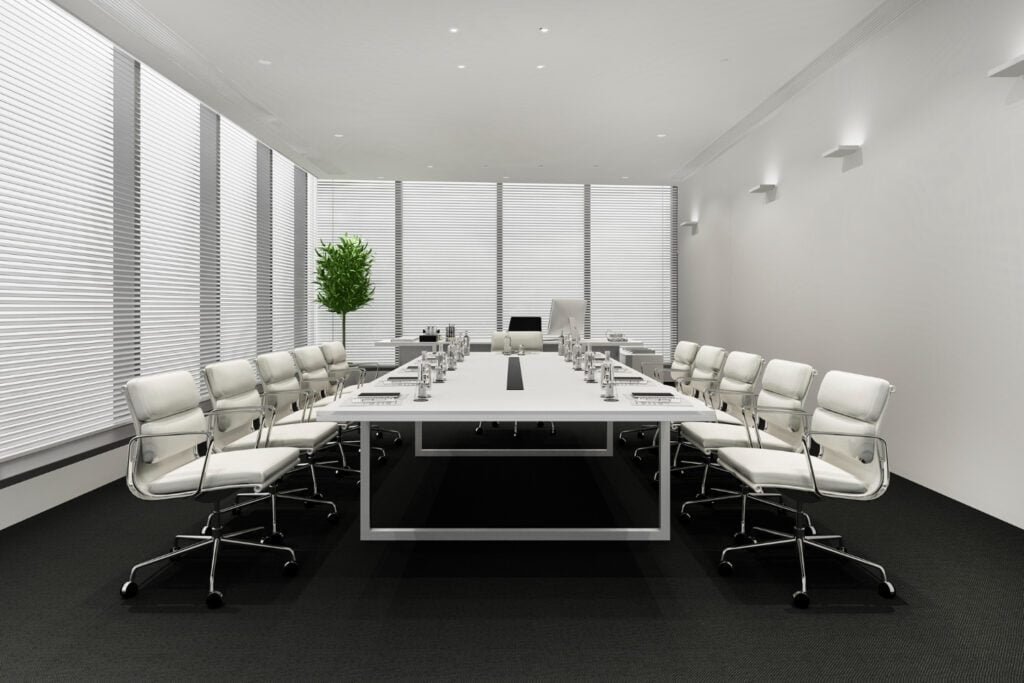
Design Features:
- Comfortable sofas and armchairs.
- Coffee tables instead of traditional desks.
- Relaxed lighting and warm, inviting colors.
- Plants and natural elements for a calming atmosphere.
Why It Works:
Perfect for informal meetings and creative sessions, the lounge-style space offers a relaxed environment that can help reduce stress and promote open communication. It’s an excellent choice for brainstorming and team-building activities.
5. The Glass-Enclosed Room
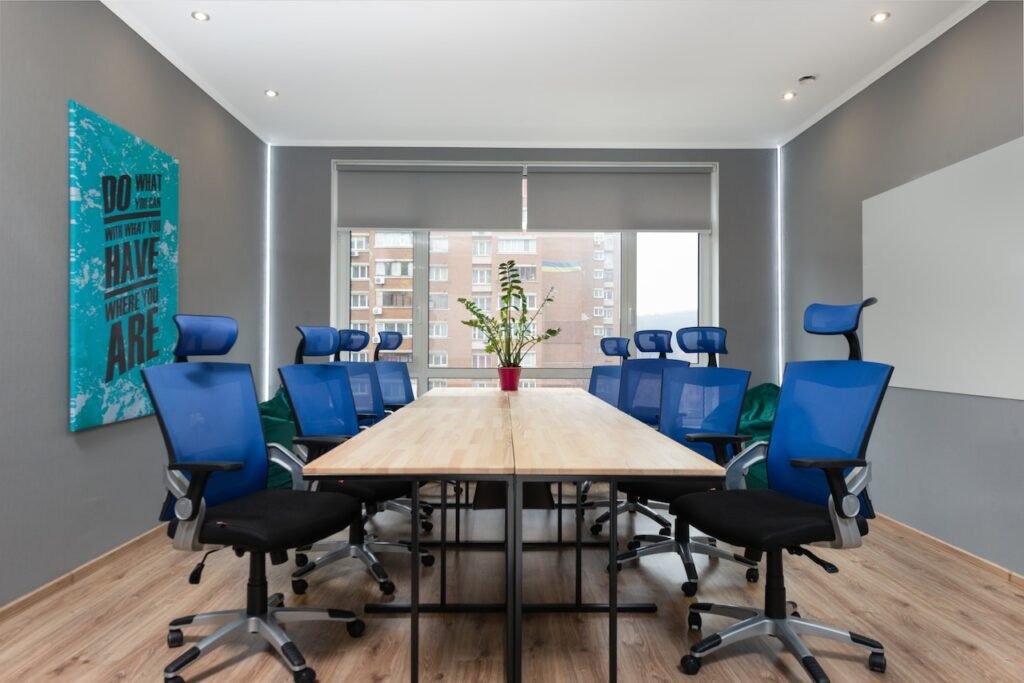
Design Features:
- Floor-to-ceiling glass walls.
- Sleek, modern furniture.
- Natural light with adjustable blinds for privacy.
- Minimalistic décor with a focus on transparency.
Why It Works:
Glass-enclosed conference rooms create a sense of openness and transparency while still providing a private space for meetings. The natural light can enhance mood and productivity, making it a popular choice for modern offices.
6. The Multi-Functional Space

Design Features:
- Modular furniture that can be reconfigured.
- Rolling whiteboards and partitions.
- Stackable chairs and collapsible tables.
- Storage solutions for easy access to supplies.
Why It Works:
Flexibility is key in this design. The ability to quickly transform the room for different purposes—such as workshops, training sessions, or small group meetings—makes it a versatile and valuable addition to any office.
7. The Artistic Room
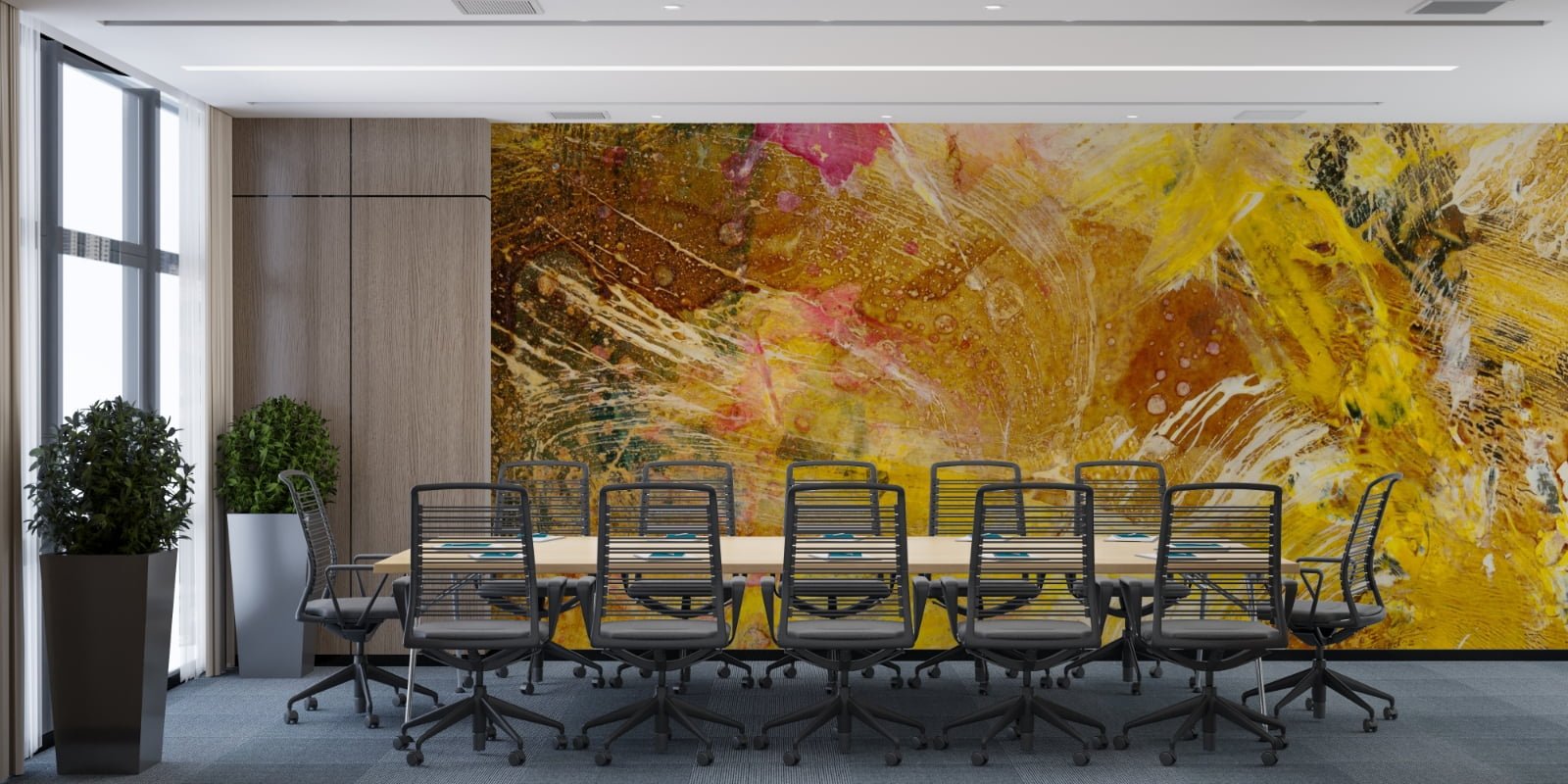
Design Features:
- Bold, artistic décor and wall art.
- Unique furniture pieces with creative designs.
- Vibrant colors and interesting textures.
- Space for displaying employee artwork or inspirational quotes.
Why It Works:
An artistic conference room can stimulate creativity and provide a refreshing change from standard office designs. It’s particularly beneficial for creative industries and teams that thrive in visually stimulating environments.
8. The Nature-Inspired Space
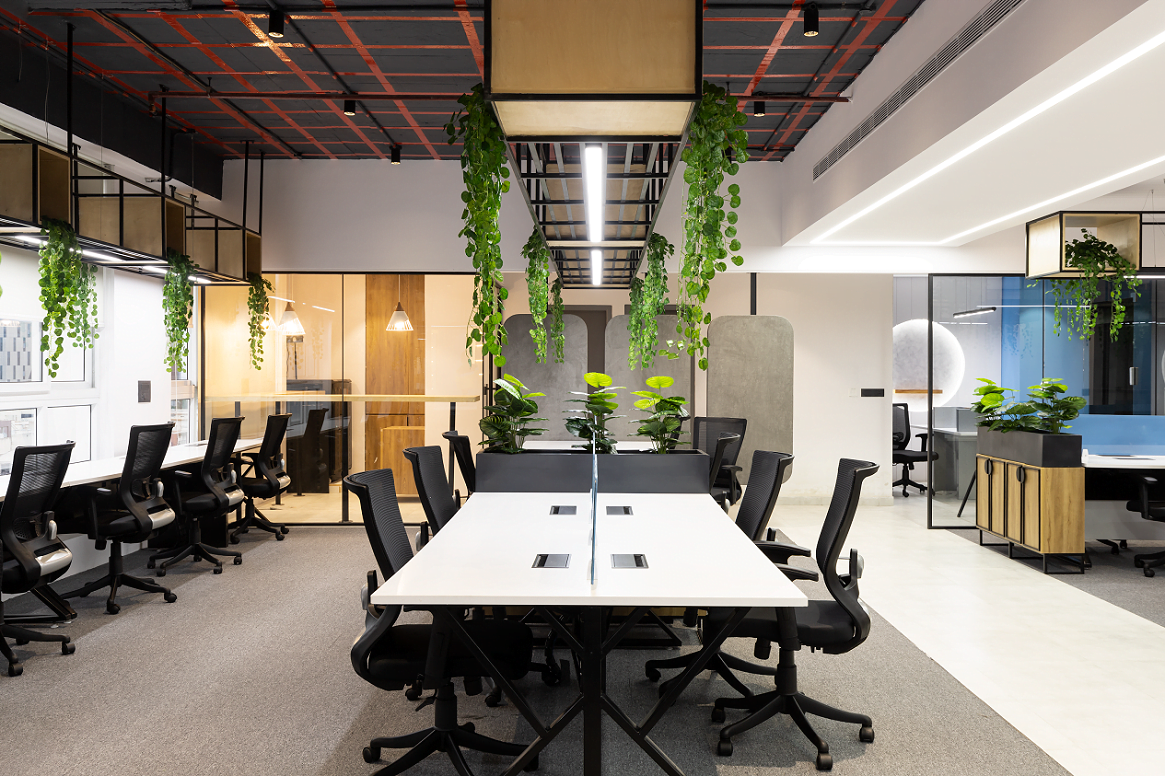
Design Features:
- Natural materials like wood and stone.
- Green walls or plenty of potted plants.
- Large windows with views of the outdoors.
- Soft, natural lighting.
Why It Works:
Incorporating natural elements into your conference room design can improve mood, reduce stress, and increase productivity. The connection to nature creates a serene atmosphere that’s conducive to thoughtful discussions and problem-solving.
9. The Executive Suite
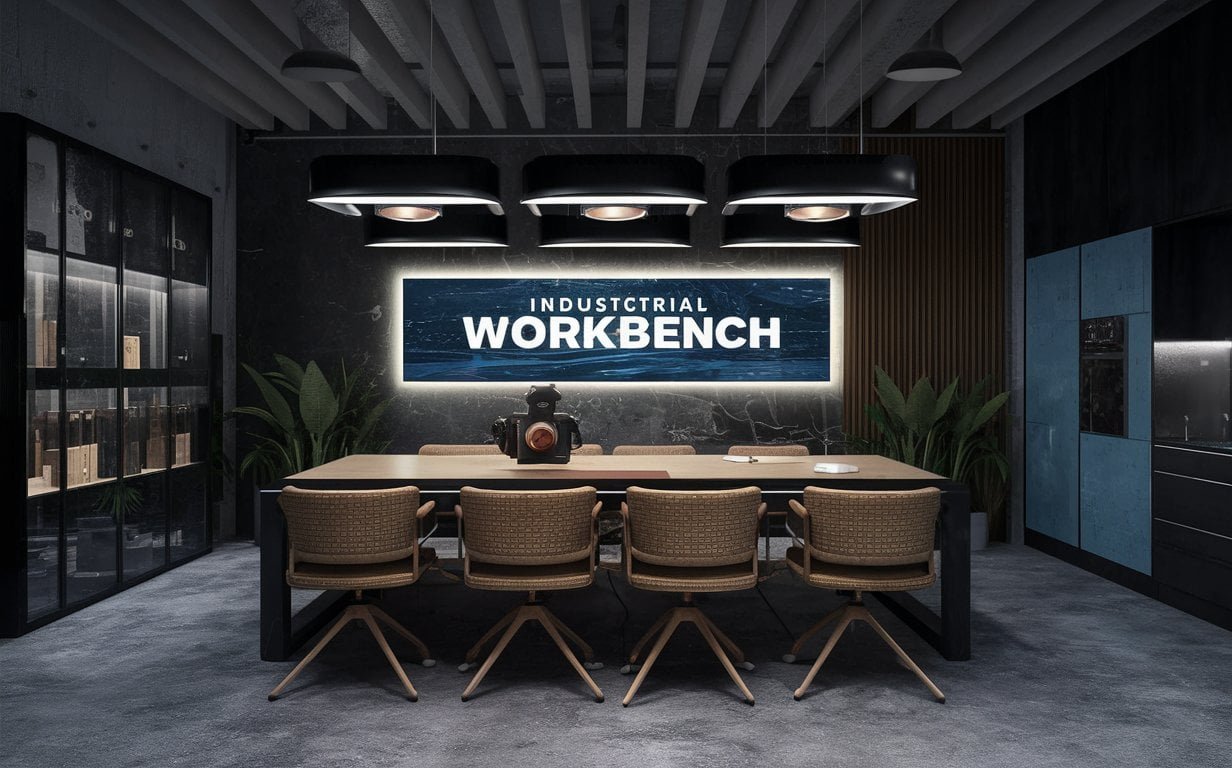
Design Features:
- Luxurious materials and high-end finishes.
- Custom-built furniture with ergonomic features.
- Advanced AV equipment and seamless technology integration.
- Elegant, sophisticated décor with a cohesive color scheme.
Why It Works:
This design is perfect for high-level meetings, impressing clients, and making important decisions. The luxurious ambiance reflects the company’s success and attention to detail, creating a professional and impressive space.
10. The Small Meeting Nook
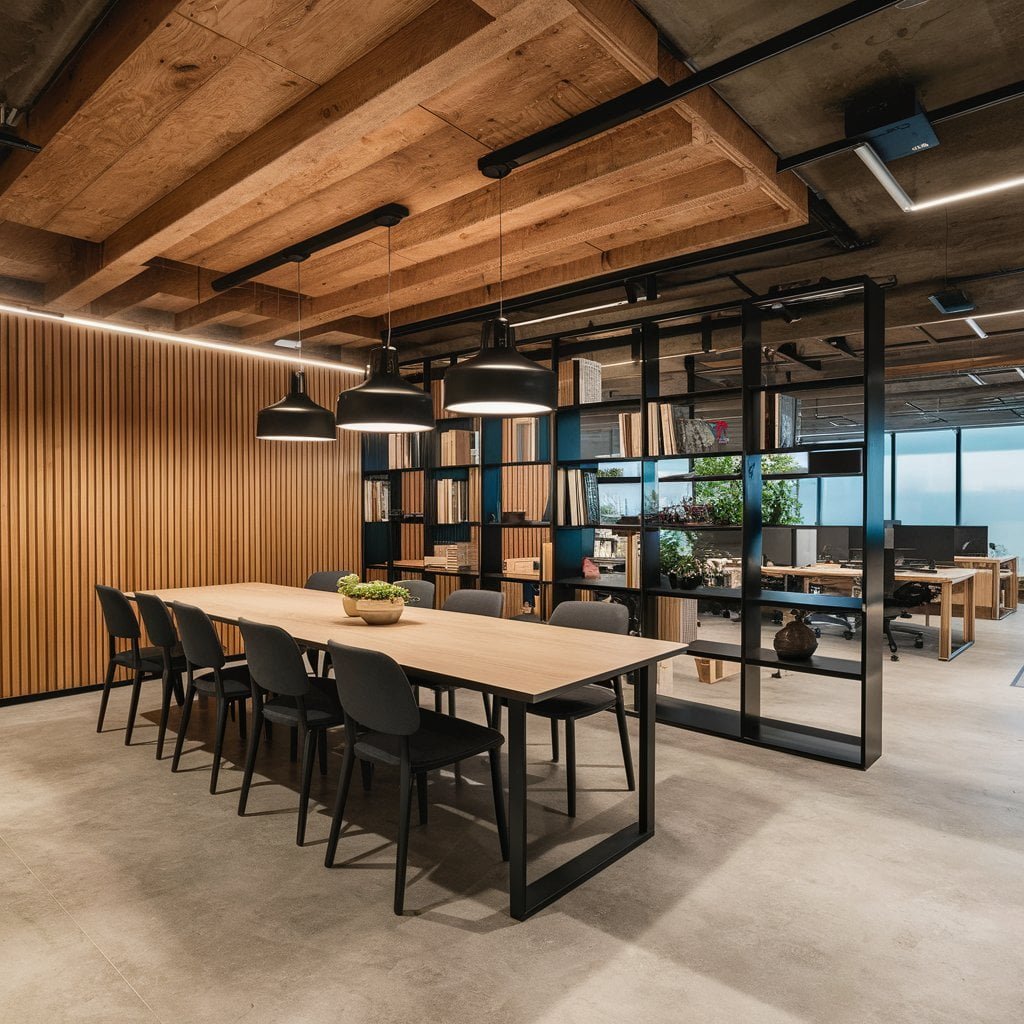
Design Features:
- Compact table and chairs for 2-4 people.
- Cozy, private setting with soundproofing.
- Simple, functional décor.
- Easy access to power outlets and a small screen or monitor.
Why It Works:
Small meeting nooks are ideal for quick huddles, one-on-one meetings, and small group discussions. They offer a private space that’s perfect for focused conversations without the need for a large conference room.
Conclusion
Choosing the right conference room design for your office can greatly enhance your team’s efficiency, creativity, and overall satisfaction. Consider your company’s culture, the nature of your meetings, and the available space when selecting the perfect design. Whether you opt for a classic boardroom or a relaxed lounge-style space, the key is to create an environment that supports your team’s needs and goals.
FAQs
How can I Make the Conference Room More Comfortable?
To make a conference room more comfortable, consider ergonomic chairs and adjustable tables to accommodate different body types and postures. Incorporate soft lighting that reduces glare and eye strain, and use sound-absorbing materials to minimize noise. Add elements like temperature control, air purifiers, and greenery to enhance the ambiance. Personal touches such as comfortable cushions, armrests, and easily accessible charging stations can also contribute to a more inviting and user-friendly space.
How can I Distinguish a Conference Room From a Meeting Room?
The distinction between a conference room and a meeting room often lies in their size and intended use. Conference rooms are typically larger and equipped for formal gatherings, presentations, and executive meetings, often featuring advanced audiovisual equipment and a long table to seat many participants. Meeting rooms, on the other hand, are usually smaller and designed for more informal, day-to-day team meetings or brainstorming sessions, with flexible seating arrangements and fewer technological requirements.
What is a Smart Conference Room?
A smart conference room integrates advanced technology to facilitate seamless and efficient meetings. This includes features like interactive whiteboards, high-definition video conferencing systems, wireless presentation capabilities, and smart lighting and climate controls. These technologies enhance communication, streamline meeting setups, and create a more productive and engaging environment. Additionally, smart conference rooms often include automated scheduling and occupancy sensors to optimize room usage and availability.
What is the Purpose of a Conference Room?
The primary purpose of a conference room is to provide a dedicated space for formal meetings, presentations, and collaborative work. It is designed to facilitate effective communication and decision-making among team members, clients, and stakeholders. Conference rooms are equipped to support various meeting formats, from large presentations to strategic planning sessions, ensuring that participants have the necessary tools and environment to achieve their objectives. The space also serves to enhance the professional image of the company and create a conducive setting for productive discussions and interactions.


